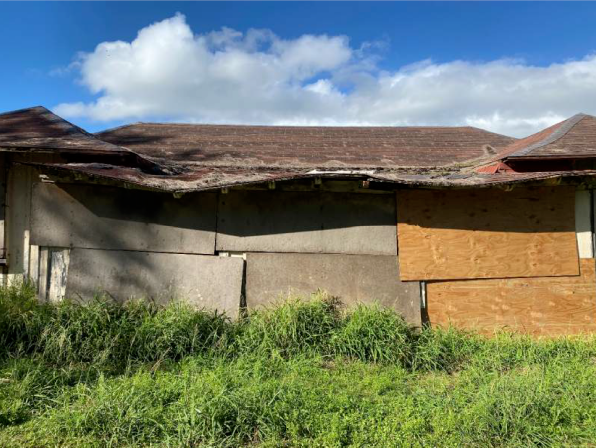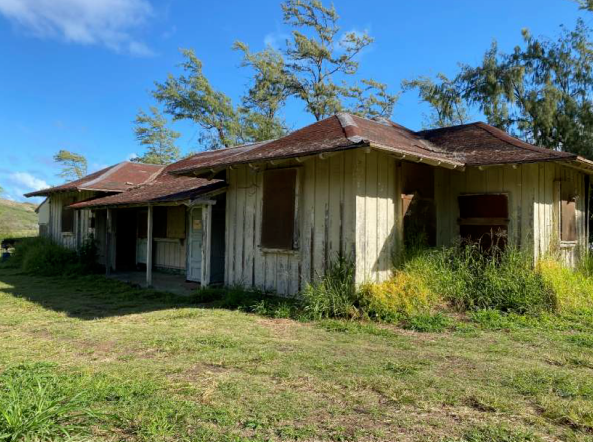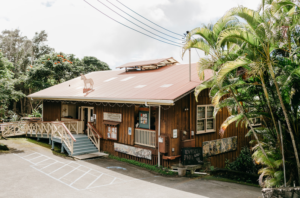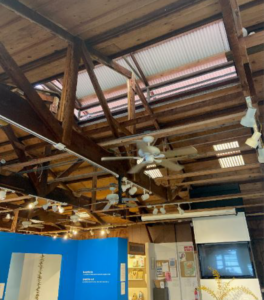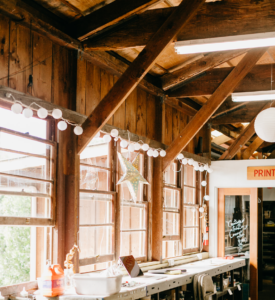The Sam and Mary Cooke Preservation Fund for Hawai‘i supports preservation activities and projects that help preserve and enhance historic places in Hawai’i for future generations. In the second half of 2021, these four projects were awarded grants from the fund.
Adaptive Reuse Restoration Assessment and Production of Schematic Design for CW Dickey House, Waihe‘e, Maui
The Hawai‘i Islands Land Trust (HILT) plans to restore the Plantation Manager’s House at Waihe‘e Coastal Dunes and Wetlands Refuge for use as a cultural education center. The house was designed by architect C.W. Dickey in 1937 for the former Wailuku Sugar Company’s Waihe‘e Dairy as a beach cottage for the plantation manager. The 3-bedroom 2-bathroom home displays a classic example of the signature “Dickey Roof” and looks strikingly similar to the architect’s own home in Waikīkī. The house has been unused since 2004 due to its poor condition and is beginning to collapse.
- The front of the house is boarded up with plywood to prevent further weather damage.
- Rear View of the Exterior.
Waihe‘e Coastal Dunes and Wetlands Refuge is a 277-acre property located on Maui’s north shore. It is owned and maintained by HILT, which has restored a large portion of the land to serve as a native wildlife habitat, while also preserving the area’s significant archaeological and cultural features. The Refuge is thought to be one of the earliest sites on Maui, containing at least 93 archaeological sites ranging from the 10th century to the plantation era. Once populated with two thriving villages, Kapoho and Kapokea, the property contains loko i‘a, a fishpond, and several heiau. The sand dunes along the coast are geologically significant as the last remaining segment of dunes formed during the Ice Age about 20,000 years ago. The dunes are being preserved as a sacred site of Hawaiians burials.
The restoration of the C.W. Dickey House for use as a cultural education center will include a classroom where students visiting on field trips can learn about the area’s history, geology, and eco-system, as well as land conservation, Hawaiian stewardship practices and climate science. The Center will also include a staff work room and a temporary storage space for iwi kupuna that become exposed due to erosion and will require a secure location until they can be properly reinterred. The preservation grant will fund a project assessment, development of schematic plans, and a cost estimate for the restoration of the house.
Consulting Services for the Repair and Restoration of the Former Theodore Atherton Cooke Home
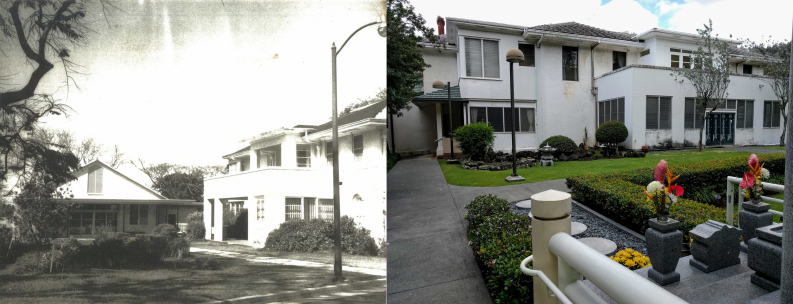
The Theodore A. Cooke house on left, circa 1960, and in 2019. Photos courtesy Nichiren Sect Mission.
The grant funds the preparation of a phased repair plan and proposal for the restoration of the historic Theodore Atherton Cooke Residence, located at 3058 Pali Highway, Honolulu. Theodore Cooke was the grandson of Amos Starr Cooke of the New England Eighth Company of missionaries and uncle of Samuel A. Cooke. The 7,800 square foot home contains 16 rooms and was designed in 1917 by architect E.A.P. Newcomb. The estate features a garden designed by Japanese landscape architect Kiyoshi Takano, who also designed Samuel Mills Damon’s original Japanese garden.
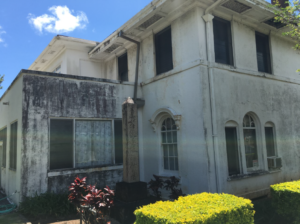
Mold and mildew stains on the windward side of the home; photo Kalei Kini
In 1956, the Nichiren Sect Mission of Hawai‘i acquired the home and pond portion of the estate in 1956. Historically, the home was used for administration, church services, as a dormitory and place of study, and to host Buddhist celebrations. However, due to a decline in membership, like other religions of faith, the Mission will need to revisit its future use of the home and formulate a plan to raise the income needed to maintain it.
Funds will be used to “develop an actionable plan to stop the deterioration of an approximately 100-year old building which sets and keeps the character of its neighborhood.” The roof and exterior walls require immediate attention. The plan will also identify the next set of tasks and costs for further restoration. The restoration is anticipated to be executed in phases and supported by additional fundraising and grants.
Editor’s note: Since this grant was approved in October 2021, the applicant completed the restoration plan and also received additional funding from the HHF Preservation Grants program to help fund the roof restoration, gutter replacement, eaves repair, wall restoration and repainting, and other preservation work.
Historic Structure Report for Donkey Mill Art Center Master Plan
The Donkey Mill Art Center is recognized by the Pūlama Ia Kona Heritage Preservation Council as a point of interest along the Kona Heritage Corridor, a segment along Māmalahoa Highway that runs between Honokahau and Honalo, and designated as Hawai‘i’s first State Scenic Byway in March 2009.
The Art Center building played an integral role in the development of the coffee industry in Hawai‘i, serving as the site of the first farmers’ cooperative, the Kona Coffee Cooperative, in the heart of Kona coffee country. The main building was constructed in 1954 by George Harada, a representative of the Soil Conservation Service, as a measure to support farmers who were struggling with declining coffee prices at the time. The Cooperative dissolved in 1981 upon the death of Harada. It was sold to United Coffee Corporation and later purchased by Desmond and Lisen Twigg-Smith. In 2001, the mill became the new home of Hōlualoa Foundation for Arts and Culture (HFAC). After volunteers adapted the historic site into functional studios, classrooms and exhibition space, the site was reopened in 2002 under its current name as a place of exploration of the arts and culture.
The goal of the grant project is to produce a historic structure report that will inform current, mid- and long-term stewardship plans and protocols to preserve the historic building. Further on, a master plan for the 2.6 acre campus will be supported by pro bono services from two architects and a project manager.
- Donkey Mill Art Center; photo Justine Grajski
- Interior open wood trusses and ventilation; photo Ashley Raymond
- Wooden windows on the eastern side; photo Justine Grajski
Publication of Booklets on Alfred Yee and Breeze Blocks by Docomomo Hawai‘i
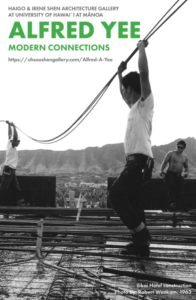 In the post-World War II era, structural engineer Alfred Yee was a pioneer in the use of pre-stressed concrete and Hawai‘i led the nation in its use. By the mid-1960s, pre-stressed concrete became a popular building material, used in large developments such as the Kāhala Hilton (1964) , the ‘Ilikai (1964), and the thirty-eight story Ala Moana Hotel (1970). Yee was the subject of a recent exhibition at the University of Hawai‘i’s School of Architecture’s Haigo and Irene Shen Gallery. For this project, the exhibit curator, Bundit Kanisthakhon, will compile and write a booklet on Alfred Yee, providing an enduring extension of the online exhibition.
In the post-World War II era, structural engineer Alfred Yee was a pioneer in the use of pre-stressed concrete and Hawai‘i led the nation in its use. By the mid-1960s, pre-stressed concrete became a popular building material, used in large developments such as the Kāhala Hilton (1964) , the ‘Ilikai (1964), and the thirty-eight story Ala Moana Hotel (1970). Yee was the subject of a recent exhibition at the University of Hawai‘i’s School of Architecture’s Haigo and Irene Shen Gallery. For this project, the exhibit curator, Bundit Kanisthakhon, will compile and write a booklet on Alfred Yee, providing an enduring extension of the online exhibition.
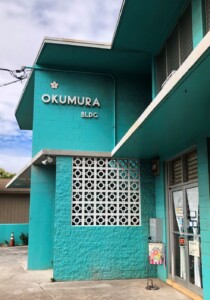
The use of breeze blocks in this is Kaimuki building exemplifies a popular mid-century style. HHF staff photo
Decorative concrete blocks, a.k.a. breeze blocks, will be the focus of the second booklet produced for this project. Serving as a decorative structural element that provided shade, air circulation, and privacy, breeze blocks were widely used throughout the 1950s and 60s, as the modern movement shifted towards minimalism. Today, with the revival of Mid-Century Modernism, breeze blocks have become a favorite throwback, used in both interior and exterior design. However, with a growing number of buildings of that time period being torn down, the form is starting to disappear. Professor Lance Walters, who has taught classes on this unique element and has identified approximately 60 different patterns used in breeze blocks in Hawai‘i, will compile and write the booklet. The project will be overseen by architectural historian and author Don Hibbard, who has partnered with Historic Hawai‘i Foundation to produce architectural booklets and presentations previously.
The project goal is to enhance the public awareness and appreciation of the unique elements of Hawai‘i’s architecture, and to encourage preservation of buildings that incorporate them. The booklets will be 64 pages each and 1,000 copies of each will be published. The booklets will be distributed to all public libraries in Hawai‘i, as well as to the Hawai‘i State Archives, and libraries of the University of Hawai‘i’ and other universities.
The Sam and Mary Cooke Preservation Fund for Hawai‘i supports preservation activities and projects that help preserve and enhance historic places in Hawai’i for future generations. Grants range from $2,500 to $10,000. Public agencies, 501(c) (3), and other nonprofit organizations are eligible to apply. Applicants are required to be Organizational Level Forum members or National Main Street Network members of the National Trust. The next application deadline is June 1, 2022. Visit Funding Sources for further information.


